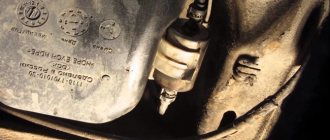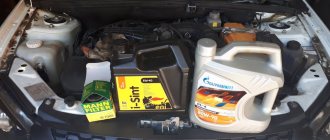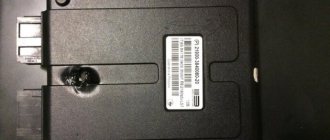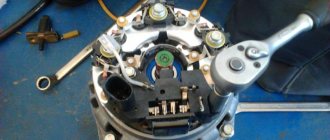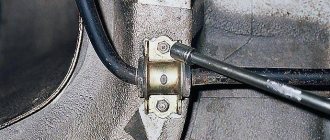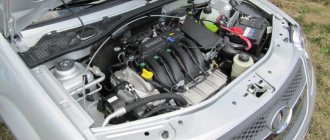No spark VAZ (injector, 8 valves)
The other day, out of the blue, the car (Kalina 1.6, 8 valves) began to shake terribly. Diagnostics showed misfires in cylinders 1 and 4. After a little checking (see how to check correctly here), I came to the conclusion that there was no spark .
And only in cylinders 1-4. Next, in order to find out the reason for the loss of spark, I will go in order.
The first thing to check is the spark plugs. The spark plug looked normal, so I didn’t have much hope that replacing it would fix the situation. And so it happened - the new spark plug still refused to produce a spark.
The second is checking high-voltage wires. They are checked with a conventional multimeter in resistance measurement mode. The resistance should be within 15 kOhm. The wires also turned out to be fine.
Third, and probably most important, is the ignition coil. She, like no one else, is responsible for the spark. Its operability is also checked with a multimeter in continuity and resistance measurement mode. First you need to check the resistance between pins 1-4 and 2-3. It should be about 4 kOhm. If the tester shows infinity, then the coil is broken and must be completely replaced. Next, check the resistance between pins 1a and 1b. There shouldn't be a break here. And the last thing is to check the central contact for breakdown to the housing. The tester should show infinity.
My reel passed the test perfectly. It seems that all the main parts are working properly, so why is there no spark? After digging a little on the Internet, I realized that I still need to check the circuit from the ECU to the coil itself.
A 3-pin chip is placed on the ignition coil, therefore you need to check these 3 wires. The central contact is +12V, which is constantly supplied when the ignition is on. The extreme contacts - 1a and 1b - provide a control signal (negative) at the moment when a spark is needed. How can all this be checked? Very simple - using a regular light bulb.
You need a lamp with a power of 1-2 W or an LED with an additional resistance of 500-700 Ohms.
We connect the lamp to the central terminal and contact 1a and ask a partner to crank the engine a little (first remove the fuel pump fuse and relieve the pressure in the rail). When cranking the starter, the lamp should flash. The same procedure must be done with pin 1b - the lamp should also blink.
When I turned on the ignition, the lamp started to light up, just constantly on (pin 1b and central). This means that the control wire has a short to ground somewhere or that the transistor (VT1) in the ECU is broken. To find out, we need to find the ECU, disconnect the wiring harness from it, find the wires we need (1b) and test them for integrity.
Having found the contact diagram, I found out that contact 1b goes to pin 5 of the ECU, 1a goes to pin 2, 3 goes to ground of the ignition circuit. I rang them for integrity - they were all intact. I called ground and everything is fine too. Therefore, you need to check the transistor in the controller itself.
My car has a January 7.2 controller. Inside there are 2 transistors that pass control signals to pins 1a and 1b of the ignition coil. So one of these transistors was broken, i.e. was constantly in the open position.
How to check the transistor for serviceability? It has 3 pins - 2 of which are soldered. It is necessary to ring each outer terminal with the central one. In both cases, the tester should not beep. The contacts must not be closed.
Now all that’s left to do is to unsolder the broken transistor (its marking is gb10nb37lz), solder a new one in its place and rejoice at the spark that appears.
Checking for spark
Let's say your fuel-injected car has stopped responding to the ignition key and refuses to start. It is quite irrational to immediately complain about a malfunction in the ignition system. First of all, you need to make sure that it is the spark that has disappeared and not something else that has broken. To check spark plugs for the presence of the coveted “light”, you can resort to several procedures at once. Perhaps the most effective and simple ones are the following:
- The first method is a mass test. To implement it, you need to turn off the ignition, unscrew each spark plug in turn and, placing its body against ground (the metal body of the engine), try to start the engine;
- The second method is checking with a multimeter or a tester based on a piezoelectric element. This diagnostic option is quite similar to the method described above, except that the spark plug is applied not to ground, but to the contacts of the tester or multimeter. However, in this case there is no need to “turn” the starter; the spark must come from the devices themselves.
Kalina won't start, the starter won't turn
Burnt starter commutator, stuck brushes or severe wear
Open or short circuit in the starter armature winding
| Possible malfunction | Diagnostics | Remedies |
| Battery is low | The voltage at the battery terminals with consumers turned off is less than 12V. When trying to start the car, a crashing sound is heard from under the hood. | Charge the battery or replace it with a new one |
| Oxidation of battery terminals or wire terminals, their fit is not tight | When you try to start the engine, the voltage in the on-board network drops much more than at the battery terminals. In this case, a crash may be heard under the hood. | Clean the contacts, lubricate them with petroleum jelly and tighten the terminals |
| The engine or attachments are jammed | Check the rotation of the crankshaft, coolant pump and alternator pulley. | Repair engine, generator, pump |
| The starter is faulty, the starter drive gear or flywheel ring teeth are damaged | Inspect the starter after removal. | Repair or replace starter |
| The starter switching circuit or starter relay is faulty, the wires are damaged, or the ignition switch contacts do not close | When the key is turned to position “II”, the starter traction relay does not operate (a click is not heard under the hood). Check the +12V supply to the control contact of the traction relay. | Replace starter relay, wires, ignition switch |
| The starter traction relay is faulty, there is a short circuit or break in the retractor winding, the relay armature is stuck | When the key is turned to position “II”, the traction relay does not operate (there is no click under the hood), but + 12V is supplied to the control contact of the traction relay. Remove the relay and check its operation. | Replace the traction relay |
| Contacts or wires of the traction relay are oxidized, poor ground contact | When the starter is turned on, a clicking sound is heard under the hood, but the starter armature does not rotate. Using an ohmmeter, check the resistance of the battery-starter circuit, as well as the ground wire. If the circuit is in good condition, remove the starter and check the operation of the traction relay by applying +12V to it from the battery | Tighten the terminals, clean the contacts, replace the traction relay |
| Open or short circuit in the holding winding of the traction relay | When you try to start the engine, you hear a crashing sound under the hood. The battery voltage is within normal limits. We check the traction relay with an ohmmeter or by its excessive heating. | Replace the traction relay |
| The starter armature rotates slowly or does not rotate at all. Check the traction relay by applying voltage to the starter contact bolt directly from the battery | Replace starter or armature | |
| Freewheel slipping | When the starter is turned on, the armature rotates, the flywheel is stationary | Replace clutch or starter |
What to do next
So, the reason why there is no spark from the coil has been discovered. Now we need to decide what to do next. There are two main options:
- repair the faulty element;
- purchase a new coil, and then replace it.
Repairing a unit is a rather complex process. Here it is necessary to disassemble the mechanism into its component elements, then check them for various chips, scratches and other defects, and then clean up the damage. Then you need to restore the shell using glue or a special composition.
To replace the coil, you need to select a model with similar parameters.
It is important to connect the connecting wires correctly, otherwise there is a high risk of overheating and a short circuit. If a spark appears during the test, and the data obtained by the ohmmeter and ammeter are within normal limits, then you should look for a problem in the remaining elements of the ignition system.
Kalina won't start, the starter turns
| Possible malfunction | Diagnostics | Remedies |
| Fuel tank empty | The needle on the fuel gauge is at zero. | Pour gasoline |
| Battery is low | The voltage at the battery terminals with consumers turned off is less than 12V. When trying to start the car, a crashing sound is heard from under the hood. | Charge the battery or replace it with a new one |
| Oxidation of battery terminals or wire terminals, their fit is not tight | When you try to start the engine, the voltage in the on-board network drops much more than at the battery terminals. In this case, a crash may be heard under the hood. | Clean the contacts, lubricate them with petroleum jelly and tighten the terminals |
| Unreliable connection of electrical circuits of engine control and power supply systems | Check the connections of the connectors and the reliability of the contacts in the blocks. | Fix faulty wire connections |
| Increased resistance to rotation of the crankshaft (scores on the shafts, bearing shells, cylinder-piston parts, deformation of the shafts, frozen engine oil, jammed generator, jammed coolant pump) | The crankshaft turns slowly. If the engine is started in severe frost, and the engine was working properly the day before, then most likely the engine oil has frozen. If you hear extraneous noise when starting the engine, check the free rotation of the pump and generator pulleys. | Use the recommended engine oil. Repair the engine. Replace the pump and generator. |
| Malfunction in the ignition system | Check for spark. | Check the circuits and devices of the ignition system. Replace faulty system elements. |
| The high voltage wires are connected in the wrong order or the wire is disconnected | Inspect. | Connect the wires in the correct order |
| The timing belt is broken or the belt teeth are cut off | Open the front timing cover and check. | Replace timing belt |
| Disturbed valve timing | Check the marks on the crankshaft and camshaft pulleys. | Set the correct shaft position |
| Malfunction of the computer (brains), its circuits, crankshaft position sensor or coolant temperature | Check the supply of +12V to the ECU, the sensor circuit, and the absence of damage to the sensors themselves. | Replace ECU, sensors. |
| The idle speed controller or its circuit is faulty | Check the idle air control. When starting the engine, lightly press the gas pedal. If the engine starts and stalls when you release the gas pedal, the sensor is faulty. | Replace sensor |
| The fuse is blown or the main relay of the control system is faulty | Check fuse and relay. | Eliminate the cause of the blown fuse. Replace fuse and relay |
| Fuse blown, fuel pump relay. Circuit, relay or pump is faulty. | When the ignition is turned on, there is no sound of the pump running. Check the fuse. Apply voltage to the pump from the battery. | Clean contacts, replace faulty circuits, replace fuse, pump and relay. |
| The fuel filter is dirty, the water in the fuel line is frozen, the fuel line is damaged | Check the pressure in the fuel rail and the condition of the fuel lines. | Replace the filter, blow out or replace the fuel lines. |
| Insufficient pressure in the fuel rail | Check the pressure in the fuel rail, the pump strainer and the condition of the fuel lines. | Clean the filter. Replace pump, fuel pressure regulator |
| Faulty injectors or their power supply circuits | Check the injector windings with an ohmmeter. Check the chains for breaks. | Replace injectors, replace chains |
| Air leak into the intake tract | Inspect the joints and fittings of the hoses and clamps. During start-up, turn off the vacuum brake booster and plug the receiver fitting. | Eliminate air leaks, replace vacuum booster |
Lada Kalina does not start when cold
- If the crankshaft rotates slowly, the battery may be discharged or the engine oil may be frozen.
- The vehicle's fuel system is faulty. The water in the ramp may have frozen.
- The coolant temperature sensor (DTOZH) of the engine management system is faulty.
- Fuel injectors are leaking.
- Low compression in cylinders.
- The engine control system is faulty. Run diagnostics.
Let us remind you that regular vehicle maintenance will help eliminate engine starting problems.
Source: xn--80aal0a.xn--80asehdb
Missing spark
MISSING SPARK
So, the engine won't start? In previous conversations, we figured out how to check the electrical circuits of the fuel pump and injectors. Well, what to do if the control signal does not arrive at them? Let's start “from the stove” - the master disk. This is a gear wheel combined with a generator drive pulley (2 in photo 1). If it turns (for example, a rubber damper has peeled off), the engine will not be able to start. Perhaps you will use the experience of those who talked about this in ZR, 2003, No. 4. Otherwise, you need a new pulley.
Let's assume that the pulley with the toothed disk is in order. Then let's move on to the electrical part. If there is no spark at the same time at the spark plug and a signal at the injector, then with a high degree of probability the crankshaft position sensor (DPKV - 1 in photo 1) or its circuit is to blame. Not receiving a signal from this sensor, the controller regards the situation as an engine stop and interrupts control of the injectors and the ignition module.
To check the performance of the DPKV, remove the high-voltage wire from the spark plug of any cylinder, insert a working spark plug into the tip (possibly from a spare one) and, placing it on ground, turn on the starter. Is there a spark and signal at the injector? This means that the DPKV and its circuit are working properly and the spark plugs may need to be replaced. During this check, a reliable connection of the spark plug body to ground is extremely important, otherwise the high voltage will break through the insulation of the secondary winding of the ignition module and that will be the end of it. And for a new one you will pay about 1,500 rubles. If you do this together, then you must press the spark plug body tightly against the “ground” (for example, a valve cover), after which your assistant will turn the ignition key. And not vice versa. If you work alone, the spark plug must be secured so that the spark can be seen even from the driver’s seat. We show one of the options for fixing the spark plug in photo 2: a wire connects its threaded part to ground.
...What if there is no spark? Then we’ll check the DPKV itself. Its signal is an alternating voltage, which when cranked by the starter is about 4.5 V. How can you verify this? It is best to use a simple device - a DPKV connector with two wires.
Having disconnected the harness block from the DPKV, replace it with a connector with wires, connect a multimeter to them, switch it to the AC voltage measurement mode and turn on the starter. No signal? The sensor is at fault. Is the AC voltage around 4.5V? The sensor is ok. But perhaps its circuit is faulty. In this case, let’s check the signal coming from the DPKV to the controller contacts (diagram 1).
Having removed the negative terminal from the battery, disconnect the harness block from the controller, connect a multimeter to pins 48 and 49 of the harness block, then restore the connection between the battery and ground and crank the crankshaft with the starter. The voltage is normal, which means there is a defect in the controller itself. No signal - the sensor circuit is damaged.
It is possible that a signal is sent to the injector, but there is no spark at the spark plug. Then the ignition module circuit comes under suspicion. We remove the connector from it and turn on the ignition - voltage from the battery is supplied to contact D (photo 3 - first on the right). No 12V? We check if there is a break in the 68GP wire (diagram 2). Is there 12 V? We check the ground circuit of the module (this is contact C - second from the right in photo 3).
Most often, chain damage occurs. Failures of the controller itself are quite rare, and as for the ignition module, if the insulation of one of the secondary coils is broken, the engine, although on two cylinders, will work.
So, the algorithm is very simple: fuel pump - checking the spark on the spark plugs - checking the signal on the injectors.
Source: www.zr.ru
Checking the ignition system
CHECKING THE IGNITION SYSTEM FOR SPARK
If the engine does not start, first of all you need to check for the presence of high voltage at the output of the ignition coil and at the spark plugs. If the engine is equipped with an ignition coil made as a separate unit, it is necessary to disconnect the coil lead from the central terminal on the ignition distributor cap, connect a spark probe and crank the engine. Read the note “Only a spark probe will give you an accurate answer” later in this chapter. If the ignition system and ignition coil are working properly, then a blue spark will be visible in the spark probe (Fig. 5.15).
Rice. 5.15 . An example of connecting a spark probe in an engine with a non-contact (i.e. without a mechanical ignition distributor) ignition system. The spark plug is grounded to the cylinder head valve cover bolt. The photograph shows the recommended type of spark probe, in which the central electrode is recessed into the surrounding insulator
Using a tachometer
When determining the reason why the engine does not start or runs intermittently, monitor the tachometer readings. If the tachometer does not show the number of engine revolutions when cranking the engine (when the engine does not start) or its readings drop to zero (when the engine is interrupted), then the problem is due to a malfunction of the primary ignition circuit. The tachometer operates using a pulse signal from the primary winding of the ignition coil. Malfunction of the tachometer when cranking the engine may be associated with the following elements of the primary ignition circuit:
• Crankshaft angle sensor.
• Ignition control module.
• Primary winding of the ignition coil.
If the vehicle is not equipped with a tachometer, connect a portable tachometer to the negative terminal of the ignition coil primary winding. Remember:
There is no tachometer reading - this means that the problem is related to a malfunction of the primary ignition circuit.
The tachometer reading is normal - this means that the problem is related to a malfunction of the secondary ignition circuit or a malfunction of the fuel system.
If it is impossible to reach the ignition coil in the ignition system being diagnosed, disconnect the high-voltage wire from one of the spark plugs, connect a spark probe to it and check for the presence of a spark while cranking the engine.
Only a spark probe will give an accurate answer
The spark probe resembles a spark plug in appearance, but without a side electrode, with a discharge gap between the central electrode and the grounded body. The probe is equipped, as a rule, with an alligator clip attached to the body, with which it can be easily secured in a convenient place in the engine, ensuring contact with the vehicle ground. If the ignition system is working properly, it should be able to “pierce” this wide gap under atmospheric pressure. In the absence of a spark tester, a technician who could verify that a normal, grounded spark plug was producing a spark would be able to determine that there was nothing wrong with the ignition system. To break down the discharge gap of a spark plug removed from the engine and under atmospheric pressure, a voltage of about 3000 V is sufficient, no more. In order to penetrate the 3/4-inch discharge gap of a spark probe, a voltage of at least 25,000 V is required. Therefore, a spark in a removed spark plug does not mean that the ignition system is working normally - only a spark probe will give an accurate answer.
Remember, an intermittent spark when cranking the engine should be considered a malfunction of the ignition system, making it impossible to start the engine.
NOTE
An intermittent spark when cranking the engine should be considered a malfunction of the ignition system, due to which the engine cannot be started.
ATTENTION
In most non-contact ignition systems (which do not have a mechanical ignition distributor), the high voltage reaches 40,000 V or higher, and the high-voltage pulse is powerful enough to cause an electric shock to a person. Do not interrupt the secondary ignition circuit in the proximity ignition system to avoid damage and electric shock.
High voltage wire faulty: replace ignition coil
When performing engine tests (for example, testing the compression ratio), be sure to connect the ignition coil winding to ground. Do not allow a high-voltage discharge of the ignition coil to bypass the low-resistance channel to ground, which must be specially created for this. High-power non-contact ignition systems are capable of generating voltages with an amplitude of 40,000 V and higher. In the absence of a low-resistance channel for a high-voltage discharge to ground, an internal arc breakdown of the ignition coil can (and usually does) occur, resulting in a low-resistance channel inside the coil to the primary winding or its steel core (Fig. 5.17). This low-resistance channel is called a breakdown trace and can cause unstable engine operation under load, even if all other elements of the ignition system are functioning normally. Often such traces of breakdown cannot be detected when checking the ignition coil by any means, including flaw detection methods. Since the breakdown trace is a channel of reduced, compared to normal, resistance to the ground, in order for such a defect to appear, it is necessary for the ignition system to operate under load, but even then the defect (unstable engine operation) can either appear or disappear.
Therefore, when turning off the ignition system, to avoid damage to the ignition coil, follow the rules below:
1. Turn off the power to the ignition system to completely stop its operation.
2. In an ignition system with a mechanical ignition distributor, disconnect the ignition coil lead from the central terminal of the distributor cap and connect it with an insulated jumper to vehicle ground. (This way you will provide a channel for discharging the energy accumulated in the secondary winding and eliminate the danger of high-voltage breakdown of the ignition coil).
Source: kalina-lada.com
Lada Kalina won't start
Added by avtorin on 01/06/2018
Lada Kalina will not start - a common problem for car owners, especially after 100 thousand miles. The reasons can be very different, and so can the solutions. Why the Lada Kalina won’t start, as well as small diagnostic tricks, are in the article.
The content of the article:
All cases when Kalina does not start can be divided into several groups. So to speak,
what is needed in order to narrow down the troubleshooting range as much as possible. In addition, if you understand individual points, then it is easier to imagine the operation of the system in general.
No gasoline
Of course, for normal mixture formation you need fuel and a spark, in the case of gasoline engines. Therefore, let's pay attention to this point.
So, the first thing you should pay attention to if the Lada Kalina does not start is the operation of the fuel pump when the ignition is turned on. It should work, especially if the car was parked before. If the fuel pump does not work, first of all, check the integrity of the fuse; it is located next to the diagnostic connector, on the central tunnel. We need the middle one.
The next step is to check the fuel pump relay. It is very easy to check - turn on the ignition and listen for a click. If there is one, then feel free to go under the back seat, arm yourself with a multimeter or test light, and then connect to the connector instead of the fuel pump. Gray is a plus, black is mass. We turn on the ignition, the lamp should light up, if it doesn’t light up, then we look for a break along the path from the fuse block to the tank. But in general, most likely, it will catch fire, then we change the pump and the Lada Kalina starts and drives.
But it also happens that the Lada Kalina does not start, but the fuel pump works. It is worth clarifying that a working fuel pump does not mean that fuel is getting into the cylinders. If the starter turns, unscrew the spark plugs and look, they should be damp. If they are dry, then turn on the ignition, unscrew the cap on the fuel rail and briefly press the spool. It should hit you with a stream of gasoline.
If it doesn’t hit, we find the fuel pressure regulator (FPR), hit it a couple of times with a 13-14 key, sometimes they stick. If this does not help, we clamp the return line that goes from it to the fuel tank. Then turn on the ignition again and again (with the return line pinched) press the spool. If the fuel does not hit again, we change the fuel filter and the mesh in the tank. This will help. If it hits, it means that the RTD does not hold pressure in the ramp; it must be replaced.
If the Lada Kalina does not start, there is pressure in the fuel rail, this means that the injectors simply do not open. First, let's start with something simple - look at the crankshaft position sensor. The fact is that the control unit receives pulse signals from it, after which, in accordance with these signals, it sends pulses to the injectors. They are controlled by a minus, that is, when the ignition is turned on, they should constantly receive a plus through a common black and pink wire. There is almost always power on it, if not, we look for a break to the ECU.
If there is power, look at the crankshaft position sensor and the drive disc on the pulley. It happens, it comes off the damper and scrolls. In this case, the control unit does not understand what position the crankshaft is in, and a discrepancy with the camshaft position sensor leads to the Kalina not starting. We read how to check the crankshaft position sensor, as well as the connector to it, this is generally a disease.
No spark
As has already become clear, the first thing to do if Kalina does not start is to check the fuses and unscrew the spark plugs. They will tell you if there is fuel. Now let's consider a situation when the Lada Kalina does not start, the starter turns, there is gasoline, but there is no spark.
This is easy to check. We take either a spare spark plug or unscrew it from the cylinder. Then we put one candlestick on it and place it on the block head. Next, ask an assistant to turn the starter and watch for a spark.
The operating principle of the system is as follows. Based on the readings of the DPKV (crankshaft sensor), the processor opens the transistors installed in the ECU, there are two of them. The first is for 1.4 cylinders, the second is for 2.3 cylinders. After the transistor has opened, a short-term minus is supplied to the ignition module, despite the fact that there is always a plus on it. With a short-term passage of current through the primary winding, an induction current of the order of 13-17 kV is formed on the secondary. Then the current flows through the high-voltage wires, and then strikes a spark between the electrodes of the spark plug.
Accordingly, diagnostics of the Lada Kalina ignition system is divided into several stages. Firstly, look at the gap in the spark plugs, it should be 1.1 mm. The best spark plugs for the Kalinovsky eight-valve engine are A17DVRM. They are cheap, 300 rubles per set, but they do not last more than 15 thousand. On the other hand, at this price they can be changed every 10 thousand. In return you will get stable starting, smooth operation and good traction.
Then we take a multimeter and check the resistance of the high-voltage wires. It should not exceed 10 kOhm on the longest and 5 kOhm on the shortest wire. Well, now the most interesting thing - the ignition module. Of course, ideally it should be diagnosed using a motor tester, but not every city has one. Therefore, to begin with, we remove the chip from the module, insert the multimeter probe into the central wire, then the second one to ground and turn on the ignition. It should be 12 volts. If not, we look for a break with the ECU or change the ECU.
If we are talking about an ignition module with a 4-pin block, then the voltage is measured on the first or second pin. Next, we measure the resistance of the primary coil (where the chip fits). It should be about 1.2 kOhm; it’s unlikely to be measured more accurately. Then we measure the resistance of the secondary winding of the coils. It should be approximately the same, but there is no exact figure. Each manufacturer has its own and can vary from 7 to 12 kOhm.
There is a spark, there is gasoline, the starter turns
In this case, it is unlikely that there is a problem with mixture formation. Most often, the problem lies in decreased compression due to wheel wear or valve burnout. Normal compression should be at least 12 atmospheres. Again, you also need to look at the DPKV, as well as the master disk. Of course, it is easier to determine such moments using a scanner, at least an ELM.
Lada Kalina does not start, the starter does not turn
In this case, first of all, you need to find out the battery voltage and bring it back to normal. Next, turn the key and listen to see if the relay clicks. If it clicks, it means that voltage is supplied to it from the ignition switch. If not, it is better to replace the starter relay with a known good one.
If the Lada Kalina does not start, the starter clicks but does not turn, then first you should try knocking on the starter while an assistant clicks it. Most likely the starter will seize at some point. In this case, you need to disassemble it and change the brushes, as well as clean the spots on the solenoid relay.
Source: avtorin.ru
Reasons why a car won't start
It also happens: the immobilizer is silent, does not give any sound or color signals, but the Lada Kalina still does not start. The cause may be problems with the starter. It is even easier to recognize a failure of this device than an immobilizer. If everything is fine with the starter, when you start the engine you will always hear a healthy, peaceful rumbling of the engine. There will be no sound when the starter stalls.
How to remove a broken starter
Starter operation may be affected by a discharged battery. You can understand this by looking at the instrument panel - not a single light on it will be lit. If the lights are on, you need to check a simple test: turn on the high beam headlights and see how they burn. A dim glow confirms our guess; in this case, the battery should be recharged. Good headlights dispel all doubts in this regard.
But it also happens differently: for the first twenty seconds the headlights burn perfectly, brightly, and then they slowly begin to go out, like a burning candle. This is a bad sign, you will have to tinker. In this case, either the starter itself or the wiring has failed. The wiring is checked with a voltmeter; people call this device “tseshka”.
A lower figure indicates serious problems with the wiring. To solve them, you need to clean the contacts, inspect the fuses and wires, in case there is a break or burnt areas somewhere. If these emergency methods do not help and the car does not start again, you will have to somehow get it to the workshop. There is special equipment that will determine the causes of the breakdown in a matter of minutes.
Checking the wiring operation
There is, of course, a radical method, which is better to resort to in the most extreme cases, for example, when the car stalled somewhere in the middle of the road, far from the city. The method is called “pusher,” but there is one caveat: you need to find two or three strong guys who will agree to help a little and push the car.
In order for the engine to fire, the starter contact must be closed directly, for which the car is placed in neutral gear, or better yet, the handbrake. Having done this tricky manipulation, turn on the ignition and conduct current from any wire with the “ ” sign to the starter. The main requirement for the wire is the presence of voltage, which can be borrowed from the battery (““ to the starter, and “-” to ground) or from the lights.
When the current begins to act on the starter, it starts to move and spins the motor shaft. The car wakes up from hibernation and comes to its senses for a while. But even if the car starts up this way, don’t rush to rejoice. This is only a one-time procedure, after which the car must be taken to a service station, otherwise the repair will cost you a pretty penny.
New Lada: Windshield washer does not work
Another reason why the Lada does not start is a failure of the electronic control unit (ECU). This device is an analogue of a processor for a computer, without which there will be no work; it is the brain of the machine, its basis. If something is wrong with the ECU, a distress signal is sent throughout the car, a collapse occurs, from which it is very difficult to get the Lada out of it. Failures usually occur due to antifreeze somehow leaking from the stove.
The close proximity of the stove and the control unit is not very good for a car. If, when tuning a car or installing an alarm system, technicians forget to put in the plugs, then water gets into the ECU. Even a drop is enough for the system to fail. The only way to secure the unit is to move it somewhere under the glove compartment. By the way, on the Lada 2021 the ECU is installed there already at the factory.
Immobilizer
If the car refuses to start, then this is one of the possible reasons. You can notice problems in the operation of this system yourself. If the corresponding icon blinks on the dashboard and a characteristic beeping sound is heard, then you should read the operating instructions. If the Lada Kalina does not start, the immobilizer is a common problem. The problem is not easy to fix. In the instructions for the car, the manufacturer indicates the decoding of sounds and blinking lights - the car owner needs to count the time between flashes, the number of buzzer signals, and then read what the manufacturer writes about this.
Features of the starter and immobilizer
https://www.youtube.com/watch?v=-kE3OCc7J7w
Kalina is sensitive to poor fuel quality
Kalina was assembled using technology, some of which was borrowed from old developments, and some was taken from imported projects and slightly adjusted in our manner. Everything would be fine, but Kalina reacts poorly to the slightest tests of strength. Broken roads, low-quality gasoline or something else like that lead it to a state of collapse.
Because of this, Kalina is much inferior not only to its imported analogues, but even to the simple domestic UAZ, which, although it is a drab little car, is reliable and, with proper care, will last for decades. With Kalina there is no hope for this.
The causes of starting problems may lie in the engine. Perhaps you had to fill the car with gasoline that was not of the best quality, which contained impurities that played a fatal role in the performance of the car. Another option is that some parts are worn out and need to be replaced.
There are more complicated reasons, for example, failures in the electronic system of the power unit. In this case, it will be very difficult to cope with the breakdown on your own, and it is more advisable to turn to specialists. A defective fuel pump can also affect your car's starting, and the list of possible problems goes on and on.
New Lada: How to start a viburnum without an ignition switch
It was in vain that the AvtoVAZ team decided to follow the western path, without having the proper experience. Of course, we wanted the best, but it turned out as always. Let Kalina be a logical continuation of the well-known “fives” and “sevens”, albeit not a bright one, but a more or less reliable car. But the masters embarked on experiments that have been going on for decades, but they cannot be called successful.
Immobilizer control unit
An immobilizer is a good thing, but only when its design meets all existing reliability requirements. But Kalina’s immobilizer often fails. The problem will be indicated by a flashing signal sent by the device. You can often hear a characteristic warning sound. Fixing a breakdown is not easy.
First, you need to diagnose the immobilizer by monitoring the light bulb signals and counting them by seconds. Then you will have to look at the operating instructions, where the decoding of this Morse code should be given. Based on what signals the light bulb gave us, we decide what to do next.
How and why the immobilizer fails
Let's dwell on this topic in a little more detail. The thing is that the ECU controller on this model is located under the heater radiator. In second-generation models, the controller was moved.
First of all, when exposed to liquid, the output switch burns out. The chip can be re-soldered, but after such repairs the problems will go away for literally two months, and then they will appear again. The heater radiator will need to be replaced. If this problem exists, then experts recommend installing a new controller between the engine compartment partition and the stove.
Now about the immobilizer - in Kalina cars the manufacturer installs APS-6 immobilizers. In very rare cases, these devices fail on their own. Often, the problem is hidden in the wiring or control panel. The key fob body is held together with one self-tapping screw - the screw can be overtightened or undertightened. A crack appears on the remote device chip between the transponder contacts. In this case, if the Kalina does not start, only a spare or training key, or replacing the remote control will help.
Starter
The immobilizer has been checked and does not give any alarms, but the engine still does not want to start. Another reason for this behavior is the starter. It’s easy to notice a problem with the starter – you won’t hear the characteristic sound of the engine starting. The mechanism simply does not spin, which means the engine will not be able to start. Everything is clear here - you need to remove and check the starter.
If the Kalina does not start, the starter does not turn, then the first reason may be the battery. It may simply be discharged. If the lights in the cabin and on the dashboard are not lit, the driver will be able to immediately notice this. However, it often happens that everything is in order, but the starter still does not work. For diagnostics, turn on the high beams and get out of the car. Dim headlights are due to the battery. It is discharged, but only to a critical level, when there is not enough power to turn the starter.
If the Kalina does not start, the starter does not turn, the best way out of this situation is to charge the battery. But if the headlights are bright in high beam mode and are not going to dim, then you will have to look for the reason elsewhere.
How to understand that there is no spark from the ignition coil
First of all, you need to understand what this node is all about. In fact, this device is designed to convert current from low to high voltage. Without the normal operation of the system, the operation of the vehicle is impossible at all . You can understand that there are some problems with such an element by the following characteristic symptoms:
- the power of the power unit has decreased;
- there are certain problems with starting the engine;
- fuel consumption has increased;
- There are interruptions in the operation of the vehicle at idle speed.
Starter or wiring problems
You can use a multimeter to test the wiring. The red wire is connected to the starter contact, the black wire to ground. In a normal situation, the device will show from 12.5 to 14.5 V. If the reading is less or even zero, then there is something wrong with the wiring.
The first step is to clean the contacts, check the integrity of the wires and fuses.
This is another popular problem when Kalina does not start. ECUs are the “brains” of the car; they themselves are quite reliable, and if you don’t touch them, then no problems will happen. However, most often the ECU is flooded.
This often happens when antifreeze leaks. This has already been discussed in the section on the immobilizer. When installing an alarm system or when pulling car wires, they forget to install the plugs - water gets into the ECU. Repairing an electronic unit is a futile task.
Gasoline pump
The vagaries of the fuel pump are often observed, especially in winter. The starter works, but the Kalina car refuses to start, the fuel pump cannot be heard, and an exclamation mark may flash on the dashboard.
First of all, check the pressure in the fuel system. To do this, open the hood and look for the cap on the ramp with the injectors. You can see the nipple there - if you press it, fuel should spray out. If it splashes, then the problem is not with the fuel pump.
Another reason is the relay. There is a cover in the transmission tunnel on the passenger side. It contains power coils. To eliminate the malfunction, just knock or warm them up.
If the fuel pump does not work, then you need to get to it and check the voltage. If the multimeter shows about 12 V, then the fuel pump is working. If not, then it is worth checking the fuses, as well as the relays.


